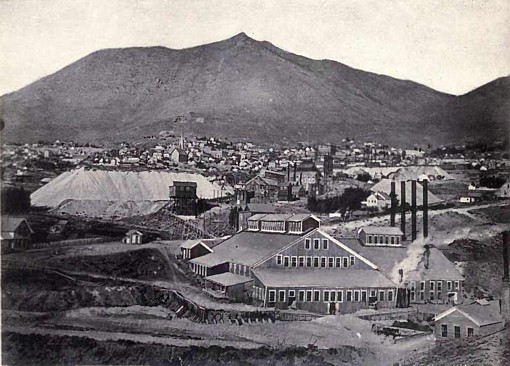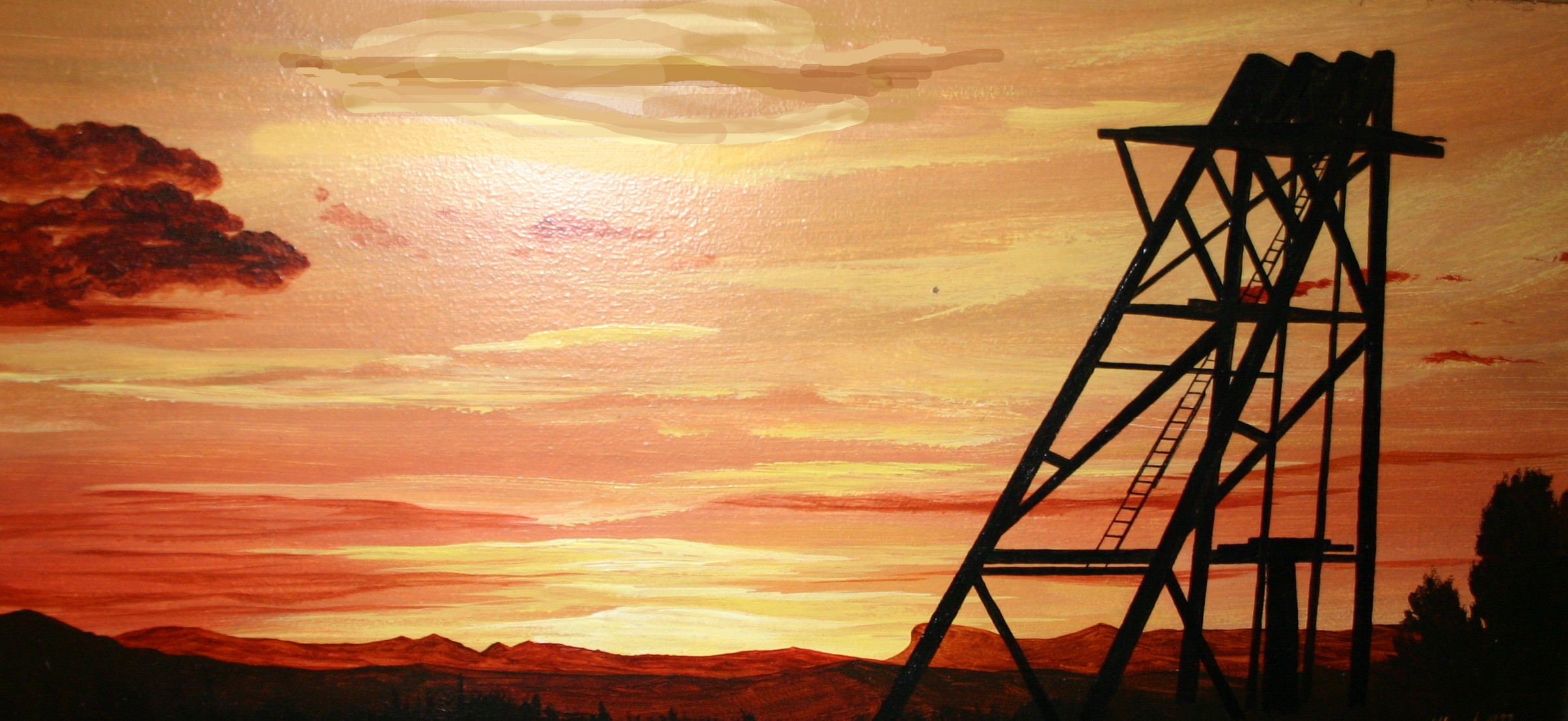Once Comstock got into the Ophir claim he elected himself superintendent and was the man who did all of the heavy talking. He made himself so conspicuous on every occasion that he soon came to be considered not only the discoverer but almost the father of the lode. As it was all Comstock for a considerable distance round the Ophir mine, people began to speak of the vein as Comstock's mine, Comstock's lode, and the lead throughout its length and breadth came to be known as the Comstock lode, a name which it bears to this day ; while the names of O'Riley and Mc Laughlin, the real discoverers, are seldom heard, even in the city that stands on the spot where they first opened to the light of the sun the glittering treasures of the vein. Even after the Ophir claim had been duly recorded and its owners had gone regularly to work upon it, they had no idea that the ore contained anything of value except the gold that was found in it. For some weeks they dug down the rich decomposed silver ore, washed the gold out of it, and let it go as waste throwing it anywhere to get it out of the way of the rockers.
They not only did not try to save it, but they constantly and conscientiously cursed it. Being very heavy, it settled to the bottom of their rockers, covered up the quicksilver they contained, and prevented the thorough amalgamation of the gold. The miners all thought well of the diggings, but for this stuff. It was the great drawback. In mining on Gold Canyon, they had been bothered with a superabundance of black sand and heavy pebbles of iron ore, but this new, bluish sand was a thing which they had never before encountered anywhere in the country. Notwithstanding their trouble with argentite, the sulfide of silver, they were taking out gold at the rate of a thousand dollars or more per day; their dust selling at about $11 per ounce. In some spots they obtained from $50 to $150 in a single pan of dirt.
About this time some ladies from Genoa visited the mine, attracted by the reports which had reached their, town of its great richness. Comstock was delighted, showed them everything and very gallantly offered each lady a pan of dirt, a piece of politeness customary in California in the early days when ladies visited a mine. " Old Pancake " was anxious that each of the ladies should get something worth carrying home, therefore by means of sly nods and winks gave one of the workmen to understand that he was to fill the pans from the richest spot. One of the ladies was young and very pretty. Although the other ladies had each obtained from $150 to $200 in her pan, Comstock was determined that something still handsomer should be done for this one. Therefore, when her pan of dirt was being handed up out of the cut (/. e. the open drift run into the lead), he stepped forward to receive it, and as he did so, slyly slipped into it a large handful of gold which he had taken out of his private purse. The result was a pan that went over $300, and Old Pancake was happy all the rest of the day. Although Comstock had a passion for possessing rich mines, and appeared to have a great greediness for gold, yet no sooner was it in his possession than he was ready to give it to the first man, woman, or child that asked for it, or to recklessly squander it in all directions.
Anything that he saw and took a fancy to he bought, no matter what the price might be, so long as he had the money. The article to which he had taken a momentary fancy, once purchased, he presented it to the first person that appeared to admire it, whether that person was white, red, or black. As work progressed, and the opening made in the hillside penetrated further into the lead, the silver sulfide, which had at first been found in a decomposed condition, began to grow more firm. In order to work it in the rockers it was necessary to pulverize much of it by beating it with the poll of a pick or sledge-hammer. Even then there were many lumps which it was necessary to pound in a mortar, and soon much of the silver ore began to assume the form of a tolerably firm rock, when it became necessary to work it in arastras an old Mexican contrivance for grinding up gold and silver-bearing quartz.
As soon as the grand strike had been made at the Ophir mine by O' Riley and Mc Laughlin, there was a great rush to that neighborhood ; not only of miners from Johntown, Gold Hill, and Dayton (then known as Chinatown), but also from the agricultural sections of the country from Washoe Valley, Tracker Meadow and from Carson and Eagle Valleys. Claims were taken up and staked off for a great distance north and south of the Ophir mine in the direction the lead was shown to run by the huge croppings of gold quartz that came to the surface, and towered far above the surface, in various places. It was not long before other companies had found pay, and soon there was in the place quite a lively little camp, the miners living in brush shanties, houses made of canvas, or camping in the open air in the sage-brush flats. At this time the camp was spoken of, in documents placed upon the records, as " Pleasant Hill " and as " Mount Pleasant Point; "in August, 1859, it was designated as "Ophir" and " the settlement known as Ophir," and in September, as " Ophir Diggings." In October the place is first mentioned as " Virginia Town," but a month later it was proposed to "change the name of the place from Virginia Town to Wun-u-muc-a, in honor of the chief of the Py-utes." Old Winnemucca, chief of all the Piutes was not so honored, and in November, 1859, the town was first called Virginia City, a name it has ever since retained. Comstock says the way the place came to take the name of Virginia City was this : " 'Old Virginia ' was out one night with a lot of the " boys " on a drunk, when he fell down and broke his whisky bottle. On rising he said ' I baptize this ground Virginia." For a time the old settlers had the new diggings all to themselves and were hard at work with their rockers, saving only the gold and pacing no further attention to the silver than to curse it for interfering with their operations ; but in a few weeks after the discovery had been made, there was suddenly stirred up in California a whirlwind of excitement that swept over the Sierras, and not only overwhelmed these first miners on the Comstock, but swept them almost out of sight.
About the 1st of July, 1859, Augustus Harrison, a ranchman living on the Trucker Meadows, visited the new diggings about which so much was then said in the several settlements. He took a piece of the ore and going to California shortly afterwards carried it to Grass Valley, Nevada county. He gave the specimen, as a curiosity, to Judge James Walsh, a resident of Grass Valley, who took it to the office of Melville Atwood, an assayer in the town. The ore was assayed and yielded at the rate of several thousand dollars per ton, in gold and silver. All were astonished and not a little excited when it was ascertained that the black-looking rock which the miners over in Washoe as the region about the Comstock lode was called considered worthless, and were throwing away, was almost a solid mass of silver ore. The excitement by no means abated when they were informed by Mr. Harrison that there were tons and tons of the same stuff in sight in the opening that the Ophir Company had already made in the lead. It was agreed among the few who knew the result of the assay, that the matter should, for the time being, be kept a profound secret; meantime they would arrange to cross the Sierras and secure as much ground as possible on the line of the newly-discovered silver lode. But each man had intimate friends in whom he had the utmost confidence in every respect, and these bosom friends soon knew that a silver-mine of wonderful richness had been discovered over in the Washoe country. These again had their friends, and, although the result of the assay made by Mr. Atwood was not ascertained until late at night, by 9 o'clock the next morning half the town of Grass Valley knew the wonderful news. Judge Walsh and Joe Woodworth packed a mule with provisions, and mounting horses, were off for the eastern slope of the Sierras at a very early hour in the morning. This was soon known, and the news of the discovery and their departure ran like wildfire through Nevada county. In a few days hundreds of miners had left their diggings in California and were flocking over the mountains on horseback, on foot, with teams, and in any way that offered. Many men packed donkeys with tools and provisions, and, going on foot themselves, trudged over the Sierras at the best speed they were able to make. Return
to The Nevada Mining Rush Page:
Nevada Gold Rush Mining History



